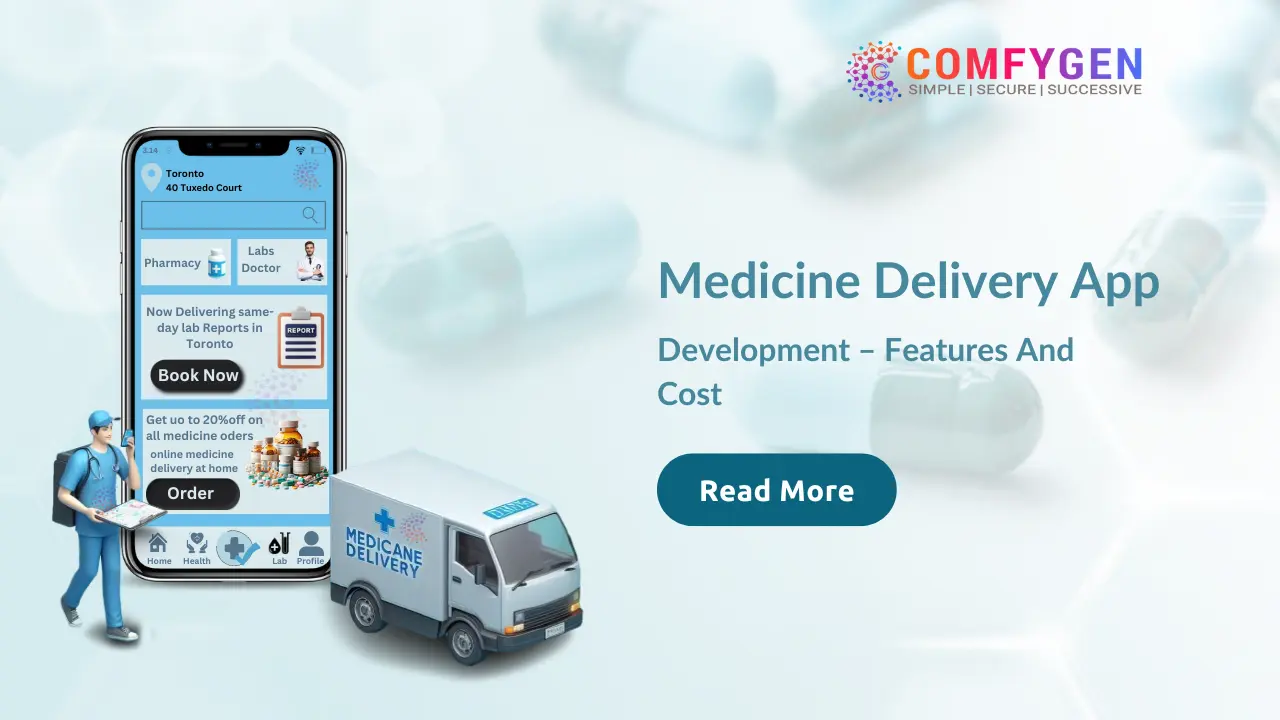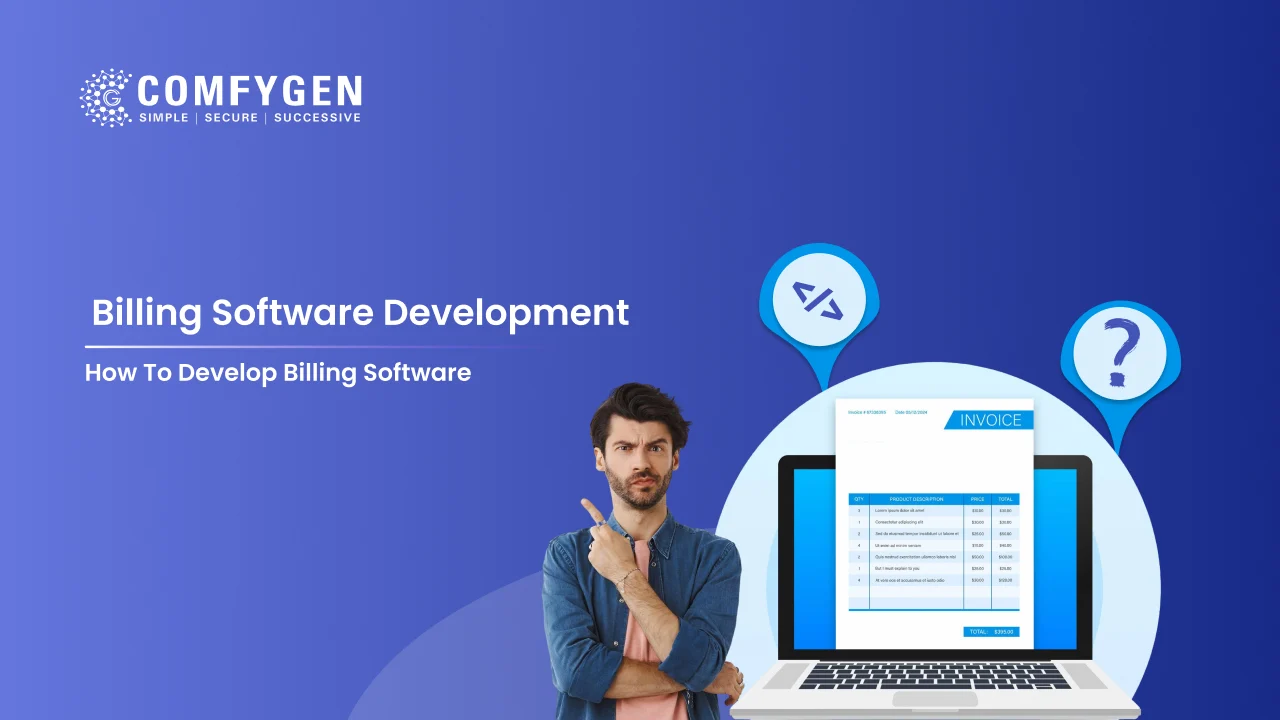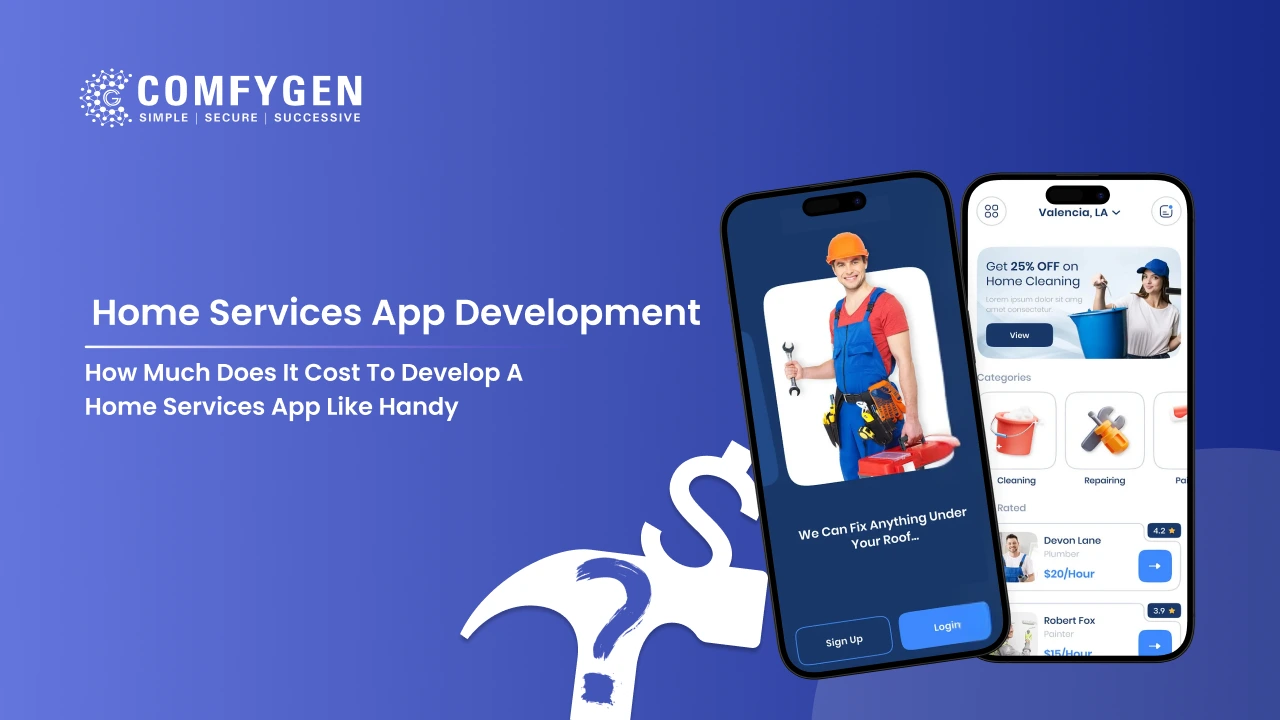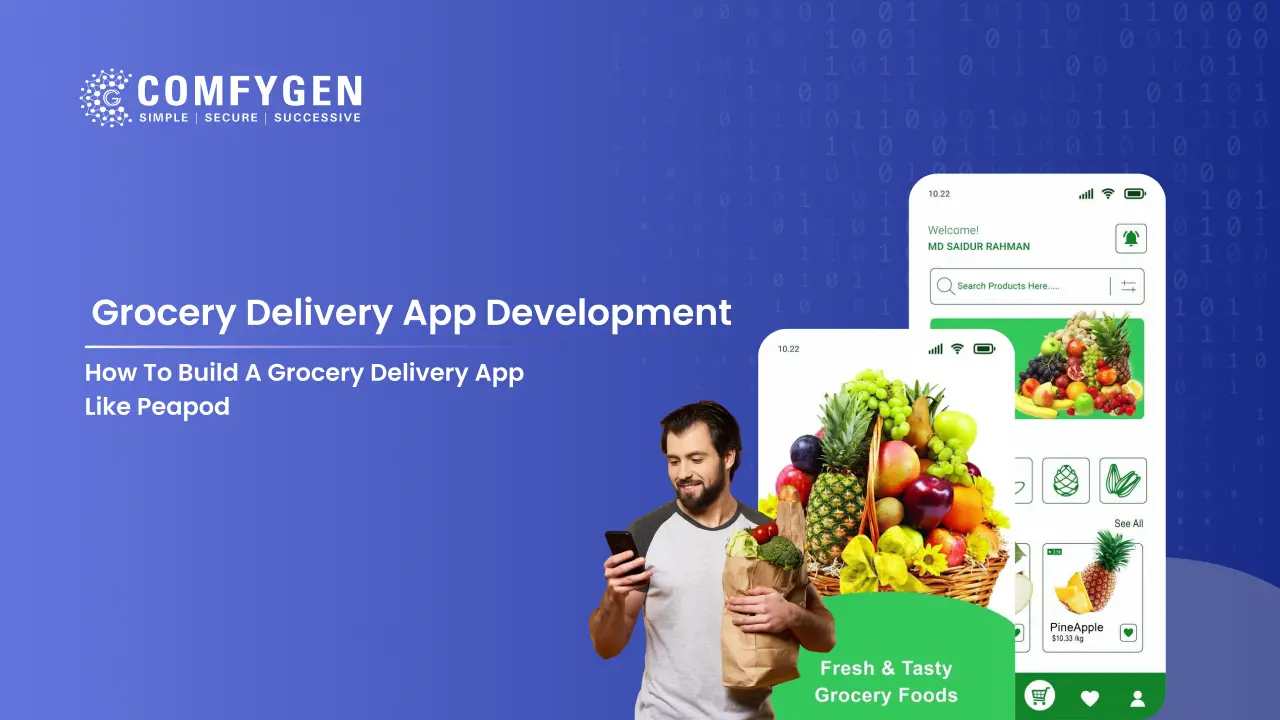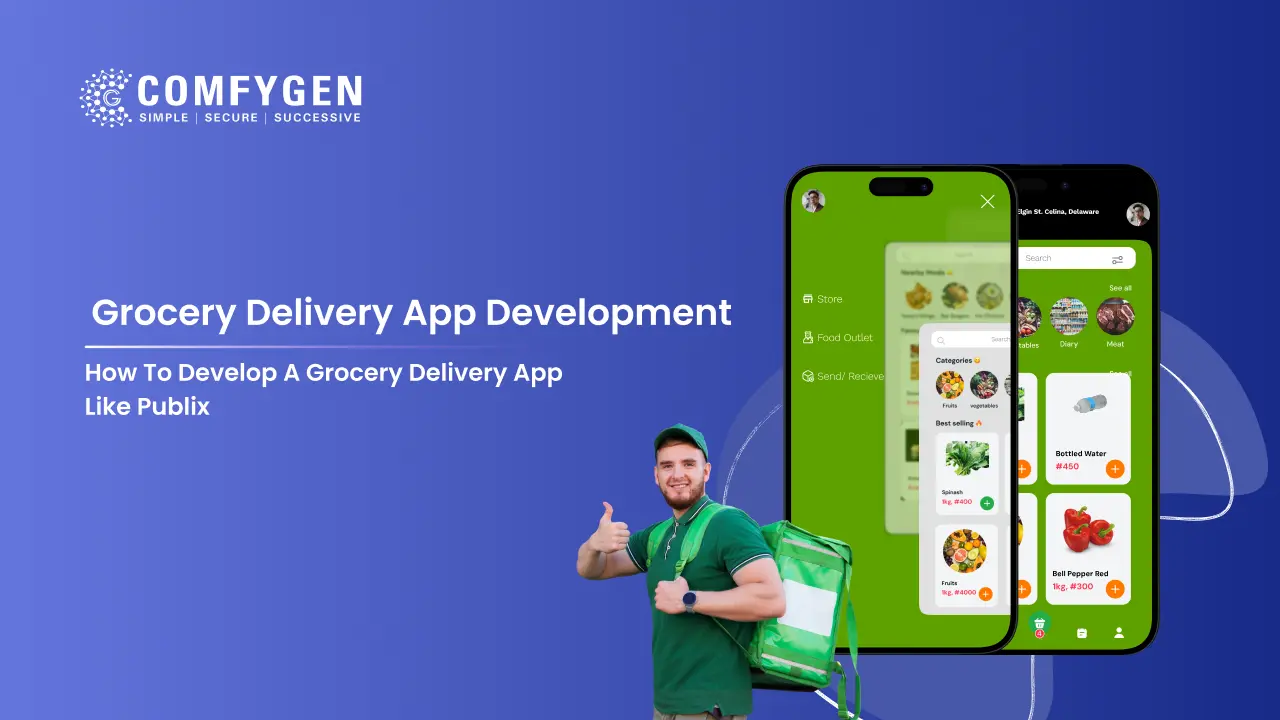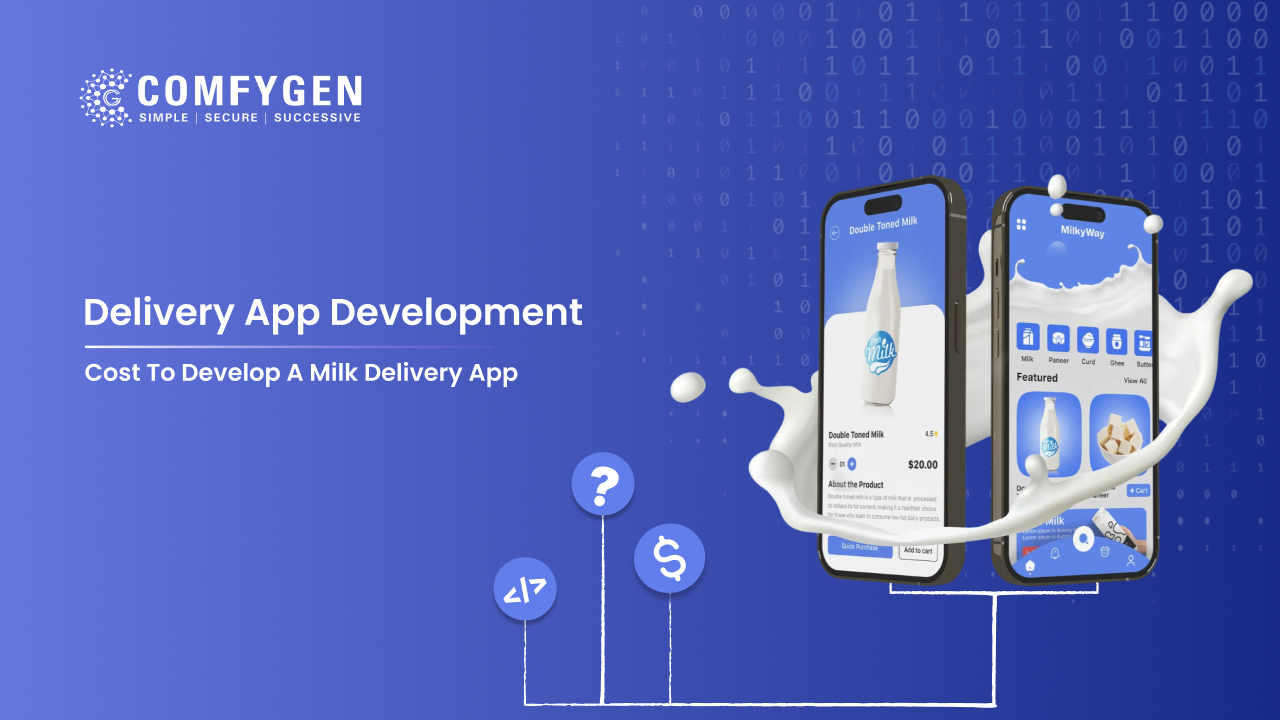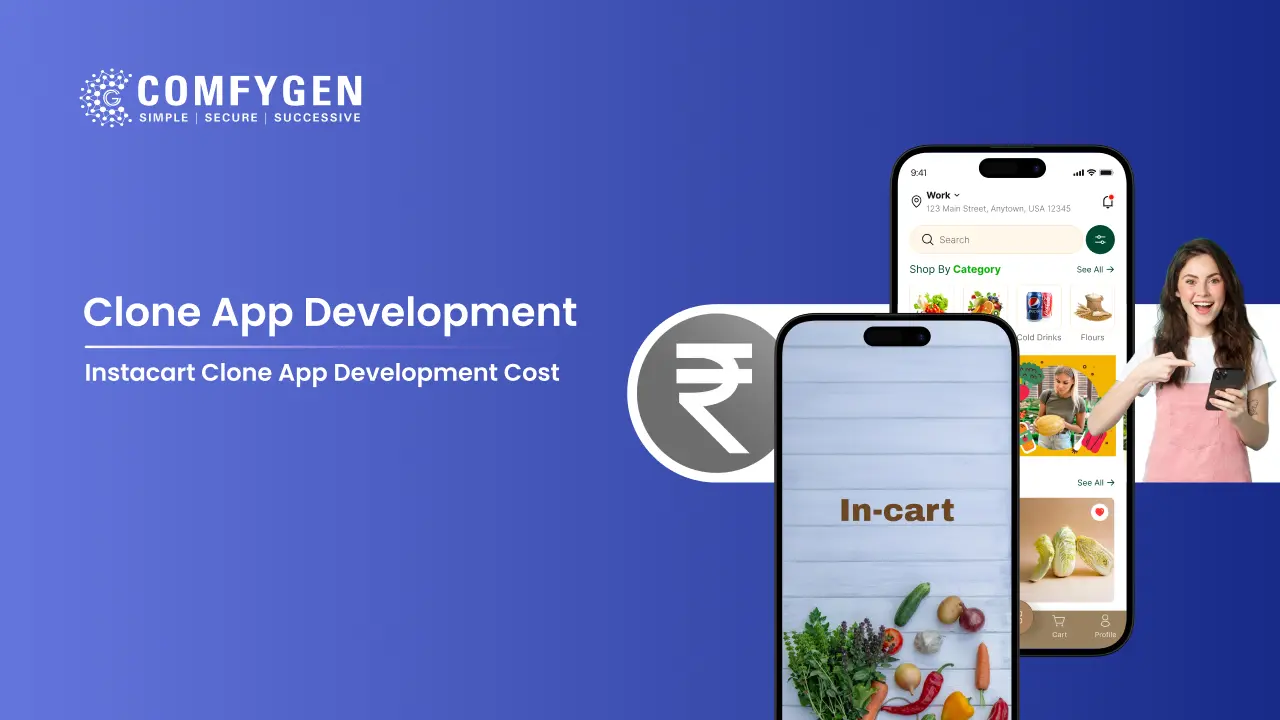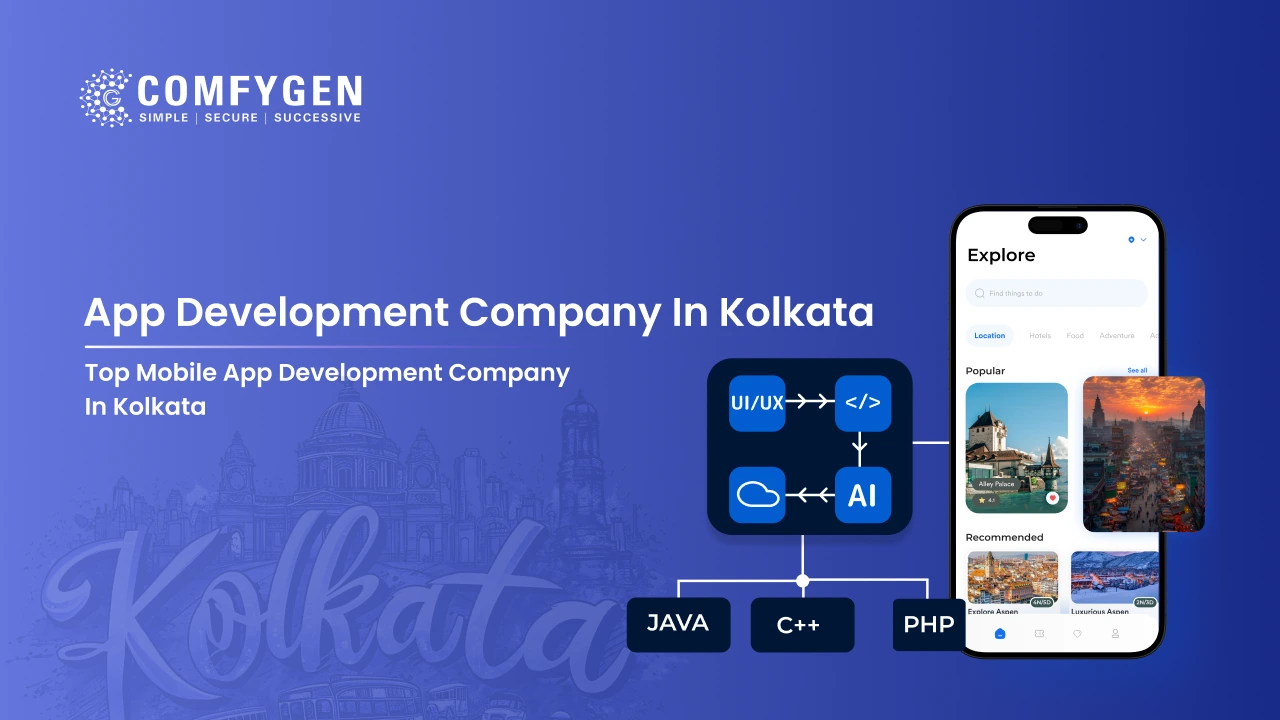On-Demand Medicine Delivery App Development – Features And Cost
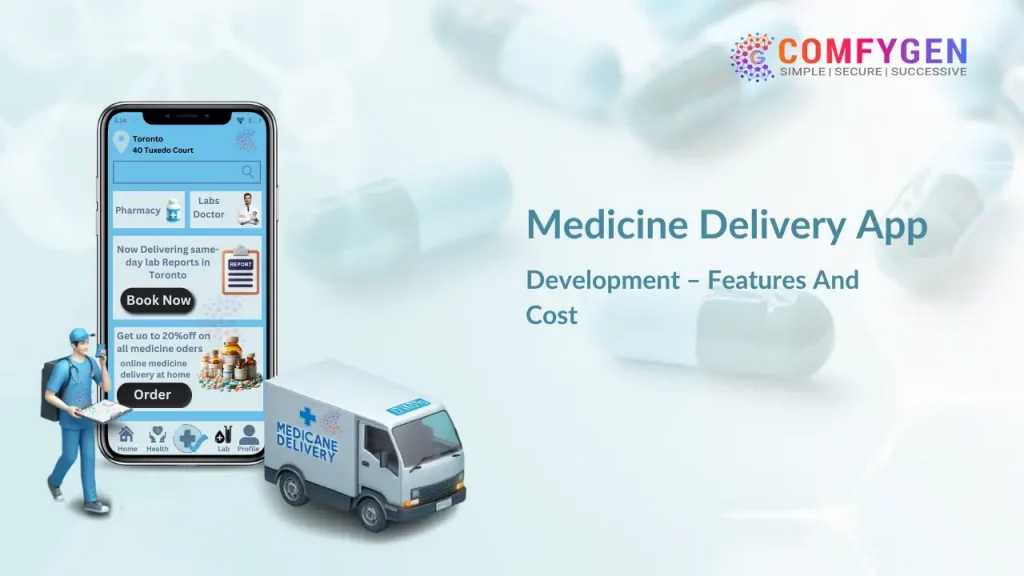
The necessity of quicker and seamless access to essential medicines on time has become more critical than earlier. Since the COVID-19 pandemic, there has been a higher demand for online medicine delivery. Now, the demand has skyrocketed in 2024 as people prioritize convenient modes.
The healthcare sector has noticed this demand and has come up with a ground-breaking smart solution with technological development, i.e., on-demand medicine delivery apps. With just a few clicks on smartphones, individuals can now have their medications delivered directly to their doorstep.
This removes the hassle of long lines and time-consuming trips to pharmaceutical stores. As the demand for these solutions grows, businesses are beginning to see the potential and profitability of entering this market. However, to succeed in this industry, they must thoroughly understand the development process and the associated costs.
Moving ahead, let us explore in detail on-demand medicine delivery app development, starting from their market overview to the development process, cost, and features. We have brought you all the valuable insights through this blog.
- Businesses and companies benefit from medicine delivery apps.
- How to build a prescription delivery app with the best business model
- A list of features that should be included in a medicine delivery app
- Stack of technologies required for the development of an online pharmacy
- An app for medicine delivery that makes money
- An in-depth guide to managing the development process
- Cost drivers for the development
Find out how to create an app to deliver medicine and turn it into a successful business.
Market Size, Stats, Trends And Opportunities
The Online Pharmacy Market revenue is expected to reach a valuation of USD 82.42 billion in 2024. The revenue is estimated to witness a CAGR of 9.63%, which is expected to reach a valuation of US$130.50 billion by 2029. The market report further shows that user penetration in 2024 is going to be 12.07%, and that will increase to 16.16% by 2029. The average revenue per user is estimated to be USD 88.14.
Market Trends
Trends are currently evolving that are widely adopted by emerging players for medicine delivery app development. The major trend is service expansion beyond medication sales. Many online pharmacies now provide a wide range of healthcare products apart from medications such as medical devices, personal care items, and supplements. This diversification helps attract a larger customer base and boosts revenue.
Another notable trend is the increasing adoption of mobile apps for online pharmacy services. Mobile apps provide a user-friendly experience that lets customers effortlessly browse and order medications and healthcare products from their smartphones. This trend is especially in higher demand in countries with high smartphone penetration, such as the United States.
Market Opportunities
The growth of the market is highly driven by various macroeconomic factors. Increasing internet penetration rates, growing healthcare costs, and rising older population all contribute to the demand for online pharmacy services, boosting the use of medicine delivery apps.
Also, through this digital platform, patients can receive e-prescriptions from licensed medical practitioners. The prescribed medications are also delivered securely and safely. These opportunities are fueling up market growth.
What Is An On-Demand Medicine Delivery Application?
The on-demand medicine delivery app is an easy-to-use mobile platform to order medicine online with just simple taps from their smartphones. Users can browse available medications, upload prescriptions, make secure payments, and consult a doctor through the app. Once an order is placed, the app facilitates seamless delivery of medications to the user’s doorstep.
Why Should Businesses Invest In A Medicine Delivery Application?
While businesses invest in a medicine delivery app development company accelerate your customer reach and eradicate location limitations. Businesses will serve a wider healthcare sector audience, which will eventually increase their sales and generate revenue.
Moreover, this investment can also improve operational efficiency through streamlined order processing and delivery logistics. With the growth of telemedicine and digital health trends, having a dedicated platform allows businesses to stay competitive in the ever-developing market.
The Features That Make Medicine Delivery Apps So Successful
Medicine delivery apps have undergone the latest technological developments and have great features. The experts have come up with advanced integration and features to make the app more user-friendly and enhance customer shopping experience.
Considering the advancements in technology, medicine delivery app owners must incorporate various features to stay competitive. These enhancements will not only improve the app’s functionality but also build trust and credibility among clients, ultimately contributing to success in this highly competitive market. Let’s check out the latest features;
- User Registration and Profiles
The online medicine delivery app has easily navigable, seamless, and user-friendly registration and profile creation features. This lets the users create their profiles and update necessary personal and medical information in detail. Moreover, user registration takes place in a few minutes and in just a few taps.
- Medicine Search and Information
To make it easy for users to search for medicines and their information, intuitive features are incorporated within the app. Users can effectively find their medications, add them to their cart, and complete their purchases successfully. Also, users will get essential information regarding the medicine uses and dosage.
- Prescription Upload and Verification
This is one of the essential features of online medicine delivery apps. Every app must have this prescription upload and verification feature as it ensures that the drug sold is safe for the patient. Most medicines have to be purchased only with a doctor’s valid prescription to understand the purpose of buying them and safety intake.
- Order Management and Tracking
Users are always curious about knowing when their order will arrive. The app has features for order tracking capabilities that let users keep track of their order status. Also, the medicine delivery app has order management features to alter and cancel their order at any time.
- Payment Gateway Integration
The most needed feature is secured payment gateway integration within the app. Developers incorporate third-party payment gateway integration for secured and guaranteed transactions. This feature ensures that every payment is handled safely and seamlessly without any hassles. Users can safely link their bank account and other payment tools like debit cards, credit cards, etc.
Also Read: The Comprehensive Guide To Medicine Delivery App Development
- Notifications and Alerts
Push notifications and alter features are enabled to give users medicine stock updates, real-time notifications about order status, delivery updates, and medication reminders. This feature keeps the user informed about their next purchase and lets them get their medicines on time.
- In-App Chat and Support
The medicine delivery app has an in-app chat feature that allows users to contact the team directly. The feature comes with 24/7 customer support to address inquiries or issues. It enhances the customer experience and provides immediate assistance with instant response.
- Consult With A Doctor
The next trendy feature in the app is doctor consultation. The application is linked to physicians who are available to check and verify prescriptions. Patients can also consult doctors to understand more about their ongoing medications and address their concerns, such as discussing their side effects.
- Ratings and Reviews
The app has a rating and review uploading feature where users can leave their ratings and share reviews on medicines, products, and services they have received from the app. This fosters transparency and helps other users to make informed decisions about their purchases. The reviews will give an idea about their delivery service, product packaging, and other essential information.
- Admin Panel Features
An intuitive admin panel within the app enables easy management of orders, inventory, and customer data. It allows administrators to oversee operations in an effective way and make data-driven decisions. It will be helpful for the app owners to update the latest information, product availability, and other things.
- Prescription Upload
This feature enables users to upload prescriptions directly through the app. This streamlines the order process for prescribed medications and ensures compliance with legal requirements and safety standards before the medicine’s delivery.
Read more: Top 10 Healthcare Apps In The USA
- Medical Compliance
The app can incorporate features to help users adhere to their prescribed medication schedules, including reminders for refills and notifications about medication interactions. Medical compliance management involves user safety by setting stringent guidelines that the healthcare service providers must follow.
- QR Code Scanner
A QR code scanner feature simplifies the process of ordering medications. It allows users to scan codes on prescriptions and product packages for quick access. The feature will unlock information and facilitate other necessary actions to be taken before or after purchase.
- Embedded CRM (Customer Relationship Management)
An integrated CRM system in medical delivery apps aids healthcare businesses in managing customer relationships, tracking interactions, personalizing marketing efforts, and improving customer retention. CRM features will form a strong relationship between the service provider and the user.
- Multi-currency Support
This specific feature facilitates transactions in different currencies. It makes the app accessible to a broader audience and caters to international customers. This will bring in multiple business opportunities, too.
Also Read: Trends And Technologies In Medicine Delivery App Development
Advanced Features Of Medicine Delivery App Development That Should Be Considered
As the healthcare market landscape continues to evolve, medicine delivery apps must be integrated with advanced features. This improves operational efficiency and ensures security. Here are the advanced features that should be considered in the development of an online medicine delivery app.
- AI and Machine Learning Integration
AI in the healthcare market witnessed a valuation of USD 14.4 billion in 2023, and it is expected to grow at 39.2% CAGR between 2024 and 2032. The AI-integrated delivery system offers real-time tracking and accurately estimates delivery times.
Medications are delivered to the correct patient without errors, resulting in a more efficient delivery process compared to traditional pharmacies. AI algorithms analyze user behavior and preferences. This lets the app offer personalized recommendations for medications. AI can predict inventory needs based on purchasing trends, reducing stock shortages and overstock situations.
Integrating Machine Learning (ML) can significantly enhance the functionality of medicine delivery apps. ML can also be utilized to optimize delivery routes, minimize delivery times, and enhance customer satisfaction. For instance, if a user frequently orders specific over-the-counter medications, the app can alert them when those items are on sale or suggest similar products.
Related Blog: Machine Learning In Healthcare Industry
- Telemedicine and Virtual Consultation
According to reports, in 2024, there were more than 116 million users opting for online doctor consultations across the globe. This was comparatively very high, from around 57 million users in 2019. The number of users of telemedicine is going to increase at a rapid rate in the upcoming years,
Telemedicine integration allows users to consult healthcare professionals directly through the app. This functionality can include video consultations, chat options, and secure messaging systems.
Users can seek medical advice without the need for in-person visits, making healthcare more accessible, especially for those with mobility issues or those living in remote areas. In addition, the ability to receive e-prescriptions during virtual consultations enhances the app’s utility. This enables users to order their medications conveniently after consultations.
Related Blog: The Comprehensive Guide To Telemedicine App Development
- Blockchain for Security
In an era where data privacy and security are paramount, implementing blockchain technology can provide an additional layer of security for patients’ sensitive health information. Blockchain technology has the potential to revolutionize healthcare by positioning the patient at the core of the healthcare ecosystem while enhancing the security and interoperability of health data.
Blockchain offers significant potential user features and meets business requirements in the complex landscape of online medicine delivery apps, enhancing traceability and transparency while providing innovative solutions to persistent challenges.
By using blockchain, the app can create a transparent record of transactions, ensuring that all medication deliveries are traceable. This feature can help build user trust, as customers will feel confident that their data is secure and their privacy is respected.
- Data Analytics and Reporting
Data analytics features are crucial for understanding user behavior, preferences, and the latest trends in the market. By integrating robust analytics features, app administrators can gain valuable insights into which medications are currently in demand, peak ordering timing details, and customer demographics. This information is valuable for implementing marketing strategies, inventory management ideas, and enhancing customer service.
On the other hand, reporting tools in Healthcare App Development can help identify areas for improvement within the app and the overall delivery process. By leveraging data, healthcare businesses can make informed decisions that lead to improved user experiences and operational efficiencies.
- AI-enabled Chatbot
Expert business leaders believe that AI-powered chatbots increase sales by 67% on average. Integrating an AI-enabled chatbot in the medicine delivery app can significantly enhance customer service.
Chatbots can handle routine inquiries well, assist users in navigating the app, and provide information about medications, delivery statuses, and more, all in real time. This feature not only improves user experience by providing immediate responses but also frees up customer support representatives to handle more complex issues.
Apart from this, an AI chatbot can help guide users through the prescription upload process or facilitate virtual consultations with healthcare providers, further streamlining the user journey.
Also Read: Top Trends In Healthcare App Development For 2024
- Wearable Device Integration
The wearable devices market size in the medical sector is projected to grow from USD 73.77 billion in 2023 to USD 428.92 billion by the year 2030. Wearable devices featured in the medicine delivery app can offer users personalized health monitoring solutions such as heart rate, activity levels, and sleep patterns. This information can be shared with healthcare providers during consultations for more informed decision-making regarding medication and treatment plans.
Moreover, the app can send reminders to users based on the data collected from their wearables, such as notifications to take medications, schedule health check-ups, or engage in physical activities, promoting a more proactive approach to health management.
Want to integrate Telemedicine Into Your Medicine Delivery Application
What Is The Cost Of Developing An App For Medicine Delivery?
The medicine delivery app development cost starts from USD 10,000 to USD 300,000. The cost can significantly increase when it is integrated with multifarious elements and features.
Cost Factors In Developing A Medicine Delivery App
The development of a medicine delivery app involves different cost-influencing factors that can significantly impact the overall budget estimation. Understanding these factors can help healthcare businesses make informed decisions and allocate resources in an effective way before consulting a pharmacy app development company.
- Platform Choice (iOS, Android, Web) For Medicine Delivery App
The choice of platform directly influences the app development costs. Developing a medical delivery app for multiple platforms (iOS, Android, and web) often costs more than focusing on a single platform. Each platform requires distinct development approaches and programming languages. This increases the complexity and time needed for development. To reduce costs, many businesses choose cross-platform solutions.
- Design Complexity
The complexity of the design also affects the app development time and costs. A simple, user-friendly interface requires less time and resources, while a more intricate design with advanced feature integration along with animations and customized layouts increases costs.
Also Read: How Much Does It Cost To Develop A Healthcare Application?
- Feature Set
The diverse range of features required to be integrated into the app impacts development costs. Basic features such as user registration, medication search, and order tracking will cost less compared to the implementation of AI chatbots, ML algorithms, Blockchain technology, Telemedicine, etc. A comprehensive feature set can enhance user experience, but at the same time, it will lead to higher overall costs.
- Third-Party Integrations
Integration of third-party services such as payment gateways, delivery management systems, doctor consultation, and health databases can significantly impact your budget. Each integration needs time for development and testing.
The costs increase because licensing fees are involved. However, these integrations are necessary today to enhance the app’s functionality and provide users with a seamless experience, making them a valuable investment despite the extra costs.
- Development Team Location and Expertise
The location and expertise of the development team also influence app costs. When you hire a local team with a high cost of living, it may lead to higher expenses compared to outsourcing to developers with lower costs. However, the expertise and experience of the development team are crucial for delivering a high-quality app. Investing in skilled mobile developers may result in higher upfront costs, but it will be beneficial in the long term.
Also Read: How Much Does It Cost To Build A Pharmacy App?
- Estimated Cost Breakdown
While costs can vary widely based on the factors mentioned above, a rough estimate for developing a medicine delivery app ranges from USD 10,000 to USD 300,000. Apps with simple features can cost USD 10,000 to USD 15,000. Also, apps with advanced features and functionalities integration can go up to USD 300,000. A detailed cost breakdown should include expenses for design, development, testing, deployment, and ongoing maintenance to provide a clear financial picture.
Want To See A Demo Of A Medicine Delivery Application?
The Medicine Delivery App Development Process
The development procedure of the medicine delivery app involves a well-structured process, from research and planning to final deployment and maintenance, focusing on meeting user needs and industry standards. Here is a brief of the key stages in the development process of medicine delivery application:
- Research and Planning
The foremost development step is thorough research and detailed planning. This phase involves identifying the target audience, understanding current market needs, and analyzing competitors. Conduct market research to define the app’s unique value proposition and features. During this stage, developers outline the app’s objectives, functionality, and overall structure. They create a detailed project plan that includes timelines, budgets, and resource allocation.
- UI/UX Design
After the research and planning phase, the next stage is the design phase. The designers and developers work together to shift their focus to UI/UX design. The expert designers create prototypes to visualize the design elements, layouts, and functionality. This stage emphasizes creating a user-friendly interface that enhances the overall user experience. They consider elements such as color schemes, typography, and navigation to ensure the app is visually appealing and easy to use.
- Frontend and Backend Development
Next comes the major part of the mobile app development process included in pharmacy delivery app development services, which is coding. Frontend developers build the client-side interface that users interact with. They focus on app responsiveness and functionality. This includes the implementation of the design elements and ensuring seamless navigation.
Backend developers also develop the server-side infrastructure that powers the app. This includes database management, API integrations, and server configurations for features such as payment processing, user authentication, and real-time tracking. Both frontend and backend development have to work harmoniously to provide a smooth user experience.
Read More: Telemedicine App Development | Benefits, Process, Features and Cost
- Testing and Quality Assurance
After the medicine delivery app is successfully developed, rigorous testing and quality assurance (QA) processes are conducted in order to detect and resolve any bugs or issues. The app undergoes functional testing, usability testing, performance testing, and security testing to make sure it operates correctly and securely.
- Deployment and Maintenance
After undergoing thorough testing, the app is all set for deployment. This stage involves launching the app on relevant platforms (such as the App Store and Google Play) and ensuring that it is accessible to users. Post-launch, ongoing maintenance is crucial to address any emerging issues, provide updates, and enhance features based on user feedback. Continuous monitoring of app performance and user engagement helps in making data-driven decisions for future updates and improvements.
If you want to develop your own medicine delivery app and look at our mobile application development services.
Contact us:
Whatsapp: +91-958-786-7258
Email: sales@comfygen.com
Telegram: @comfygen
Choosing The Right Development Partner
Did you understand the major features, cost breakdown, and development process of a medicine delivery app? Do you know what’s important next? Choosing the right Medicine Delivery App Development Company for your medicine delivery app. This is important to ensure the project’s success and reach your target audience. Here are the things to consider:
- Experience and Expertise
You need to find a development partner with a successful track record in web/mobile app development, particularly in the healthcare sector. Make sure they use the latest development features and technology stack and follow the current trends.
Their years of experience in building similar apps provide valuable insights and best practices that will benefit your project. Ensure they are familiar with relevant legal requirements, regulations, and standards in the healthcare sector.
- Portfolio and Case Studies
Do not forget the partner’s portfolio and case studies to assess the quality and diversity of their previous projects. A strong portfolio showcases their successful medicine delivery apps that will boost your confidence to believe in their ability to deliver a high-quality app.
- Client Reviews and Testimonials
Going through client reviews and testimonials offers valuable insights into the development partner’s reliable service. You will know about their communication and transparency in their service. Reach out to their previous clients and, if possible, get feedback on their experiences with apps related to the healthcare sector. If you get positive reviews and strong recommendations, they are a trustworthy partner.
- Support and Maintenance Services
The last but most important factor is the availability of support and maintenance services. The support service should be offered after the app’s launch. Ongoing support is essential for addressing issues, implementing updates, and enhancing features based on user feedback. A development partner who offers holistic post-launch support and service ensures the long-term success of your app.
Also Read: How To Develop A Medicine Delivery App Like 1mg In 2024?
Let’s Create Your Own Medicine Delivery App Together!
Are you ready to revolutionize and transform the way people access medications? At Comfygen, we specialize in developing customized medicine delivery apps that meet the unique needs of your healthcare business and your targeted users. Our team of experts will assist you throughout the entire process, ensuring a seamless experience from market research to launch.
So, want to build a medicine delivery app together with us? It is time to partner with Comfygen to create a state-of-the-art on-demand medicine delivery application that meets the needs of your customers and stands out in the competitive market. Consult us today to discuss your project.
Hire Top Medicine Delivery App Development Company For Your Project!
Conclusion
This was your comprehensive guide on understanding the essential features and app costs, as well as the development process of an on-demand medicine delivery app. Hope you have got a detailed overview to give a kick-start to your project. If you want to witness a successful project outcome with a trustworthy partner, contact the Comfygen team.
FAQs
What are the must-have features of a medicine delivery application?
What is the estimated cost of developing a medicine delivery app?
What is the duration of developing a medicine delivery app?
How do I choose the right development partner?
Can I integrate third-party services into my medical delivery app?

Mr. Saddam Husen, (CTO)
Mr. Saddam Husen, CTO at Comfygen, is a renowned Blockchain expert and IT consultant with extensive experience in blockchain development, crypto wallets, DeFi, ICOs, and smart contracts. Passionate about digital transformation, he helps businesses harness blockchain technology’s potential, driving innovation and enhancing IT infrastructure for global success.

